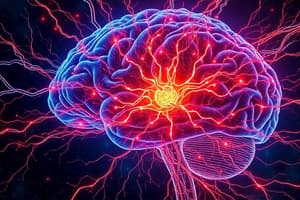Podcast
Questions and Answers
What are the functions of the parts of a neuron?
What are the functions of the parts of a neuron?
The parts of a neuron include the dendrites (receive signals), the cell body (processes signals), and the axon (transmits signals).
Explain the differences between the Endocrine and Nervous System.
Explain the differences between the Endocrine and Nervous System.
The nervous system uses electrical signals to transmit information quickly, while the endocrine system uses hormones to communicate more slowly over longer distances.
Give examples of what the human body regulates in homeostasis.
Give examples of what the human body regulates in homeostasis.
Examples of homeostasis regulation in the body include temperature, blood sugar levels, and pH balance.
Identify and explain the function of glands in the Endocrine System.
Identify and explain the function of glands in the Endocrine System.
Explain a stimulus/response model and negative feedback loop model in the context of homeostasis regulation.
Explain a stimulus/response model and negative feedback loop model in the context of homeostasis regulation.
Explain the process of a reflex action/arc.
Explain the process of a reflex action/arc.
Describe the differences between the types of neurons.
Describe the differences between the types of neurons.
Identify and explain the role of a synapse in neural communication.
Identify and explain the role of a synapse in neural communication.
Define homeostasis and provide examples of how the human body maintains it.
Define homeostasis and provide examples of how the human body maintains it.
Explain the function of hormones released by the glands in the Endocrine System.
Explain the function of hormones released by the glands in the Endocrine System.
Study Notes
Nervous System
- Consists of the Central Nervous System (CNS) and Peripheral Nervous System (PNS)
- CNS: brain and spinal cord
- PNS: nerves that connect CNS to the rest of the body
Parts of the Brain
- Cerebrum: controls movement, sensation, perception, and emotion
- Cerebellum: coordinates movement and balance
- Brainstem: connects cerebrum and cerebellum to spinal cord, regulates basic functions (breathing, heart rate)
Types of Neurons
- Sensory neurons: transmit information from senses to CNS
- Motor neurons: transmit signals from CNS to muscles and glands
- Interneurons: transmit signals within CNS
Parts of a Neuron
- Dendrites: receive signals from other neurons
- Cell body: contains nucleus and maintains cell function
- Axon: transmits signals to other neurons or muscles/glands
- Terminal buttons: release neurotransmitters into synapse
Reflex Action/Arc
- Receptor: detects stimulus
- Sensory neuron: transmits signal to spinal cord
- Integration center: interprets signal
- Motor neuron: transmits signal to effector (muscle or gland)
- Effector: responds to signal
Synapse
- Gap between terminal buttons of one neuron and dendrites of another
- Neurotransmitters released into synapse, bind to receptors on postsynaptic neuron
Differences between Endocrine and Nervous Systems
- Nervous System: fast, short-term responses, uses electrical signals and neurotransmitters
- Endocrine System: slow, long-term responses, uses hormones
Endocrine System
- Glands: pituitary, thyroid, adrenal, pancreas, gonads (ovaries, testes)
- Function of glands: regulate growth, development, metabolism, and reproductive functions
Hormones
- Released by glands into bloodstream
- Regulate various bodily functions (e.g. growth, metabolism, reproductive functions)
Homeostasis
- Regulation of internal environment to maintain stability
- Examples: body temperature, blood sugar levels, blood pH
Stimulus/Response Model
- Stimulus: change in internal or external environment
- Detection: sensor detects stimulus
- Signal transmission: signal transmitted to CNS
- Response: CNS responds to signal, sends signal to effector
- Action: effector responds to signal, restores homeostasis
Negative Feedback Loop Model
- Stimulus: change in internal or external environment
- Detection: sensor detects stimulus
- Signal transmission: signal transmitted to CNS
- Response: CNS responds to signal, sends signal to effector
- Action: effector responds to signal, counteracts stimulus
- Feedback: sensor detects response, feeds back to CNS, adjusts response as needed
Studying That Suits You
Use AI to generate personalized quizzes and flashcards to suit your learning preferences.
Description
Test your knowledge on the nervous and endocrine systems by labeling and describing the functions of brain parts, neurons, and reflex arcs. Learn about synapses and the differences between the endocrine and nervous systems. Explore the endocrine system by identifying glands and explaining the functions of hormones. Also, understand homeostasis concepts.



